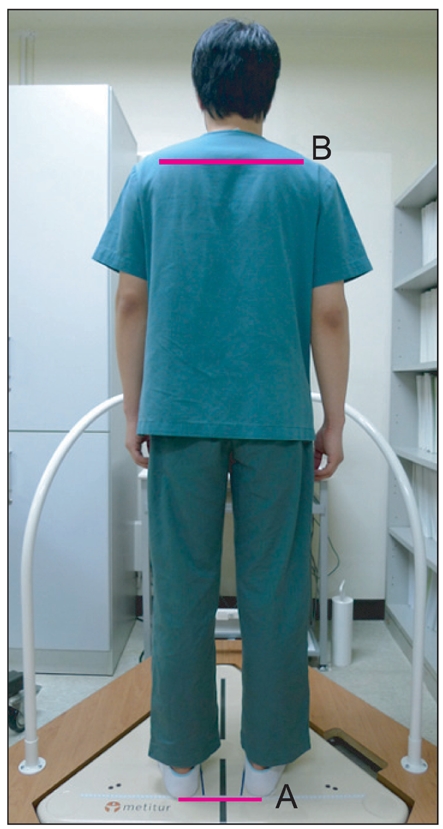1. Gonzales EG, Myers SJ, Edelstein JE, Lieberman JS, Downey JA. Downey and Darling's physiological basis of rehabilitation medicine. 2001.3rd ed. Boston: Butterworth-Heinemann; p.565-566.
2. Bronstein AM, Brandt T, Woollacott M. Clinical disorders of balance posture and gait. 1996.1st ed. London: Arnold; p.2-3.
3. Baloh RW, Fife TD, Zwerling L, Socotch T, Jacobson K, Bell T, Beykirch K. Comparison of static and dynamic posturography in young and older normal people. J Am Geriatr Soc 1994;42:405-412. PMID:
8144826.


4. Smulders E, Weerdesteyn V, Groen BE, Duysens J, Eijsbouts A, Laan R, van Lankveld W. Efficacy of a short multidisciplinary falls prevention program for elderly persons with osteoporosis and a fall history: a randomized controlled trial. Arch Phys Med Rehabil 2010;91:1705-1711. PMID:
21044715.


5. Lim JY, Lim JY, Park JA, Oh MK, Park WB, Kang EK, Shin HI, Paik NJ. Short-term and long-term effects of integrated fall prevention program in the Korean elderly. J Korean Acad Rehabil Med 2010;34:451-457.
6. Nardone A, Godi M, Artuso A, Schieppati M. Balance rehabilitation by moving platform and exercises in patients with neuropathy or vestibular deficit. Arch Phys Med Rehabil 2010;91:1869-1877. PMID:
21112428.


7. Pajala S, Era P, Koskenvuo M, Kaprio J, Törmäkangas T, Rantanen T. Force platform balance measures as predictors of indoor and outdoor falls in community-dwelling women aged 63-76 years. J Gerontol A Biol Sci Med Sci 2008;63:171-178. PMID:
18314453.



8. Kim CR, Chun MH, Lee GA. Assessments of balance control using tetra-ataxiametric posturography. J Korean Acad Rehabil Med 2009;33:429-435.
9. Sihvonen S, Sipilä S, Taskinen S, Era P. Fall incidence in frail older women after individualized visual feedback-based balance training. Gerontology 2004;50:411-416. PMID:
15477703.


10. Panzer VP, Bandinelli S, Hallett M. Biomechanical assessment of quiet standing and changes associated with aging. Arch Phys Med Rehabil 1995;76:151-157. PMID:
7848073.


11. Era P, Sainio P, Koskinen S, Haavisto P, Vaara M, Aromaa A. Postural balance in a random sample of 7,979 subjects aged 30 years and over. Gerontology 2006;52:204-213. PMID:
16849863.


12. Riley PO, Benda BJ, Gill-Body KM, Krebs DE. Phase plane analysis of stability in quiet standing. J rehabil Res Dev 1995;32:227-235. PMID:
8592294.

13. Matsumura BA, Ambrose AF. Balance in the elderly. Clin Geriatr Med 2006;22:395-412. PMID:
16627085.


14. Konrad HR, Girardi M, Helfert R. Balance and aging. Laryngoscope 1999;109:1454-1460. PMID:
10499055.


15. Benvenuti F, Mecacci R, Gineprari I, Bandinelli S, Benvenuti E, Ferrucci L, Baroni A, Rabuffetti M, Hallett M, Dambrosia JM, et al. Kinematic characteristics of standing disequilibrium: reliability and validity of a posturographic protocol. Arch Phys Med Rehabil 1999;80:278-287. PMID:
10084435.


16. Shumway-Cook A, Horak FB. Rehabilitation strategies for patients with vestibular deficits. Neurol Clin 1990;8:441-457. PMID:
2193221.


17. Loram ID, Lakie M. Human balancing of an inverted penundulum: position control by small, ballistic-like, throw and catch movements. J physiol 2002;540:1111-1124. PMID:
11986396.



18. Rogers MW, Mille ML. Lateral stability and falls in older people. Exerc Sport Sci Rev 2003;31:182-187. PMID:
14571957.


19. Herdman SJ, Schubert MC, Tusa RJ. Strategies for balance rehabilitation: fall risk and treatment. Ann N Y Acad Sci 2001;942:394-412. PMID:
11710480.


20. Whipple R, Wolfson L, Derby C, Singh D, Tobin J. Altered sensory function and balance in older persons. J Gerontol 1993;48:71-76. PMID:
8409244.


21. Rosenhall U. Degenerative patterns in the aging human vestibular neuro-epithelia. Acta Otolaryngol 1973;76:208-220. PMID:
4543916.


22. Harwood RH. Visual problems and falls. Age Ageing 2001;30:13-18. PMID:
11769782.


23. Verghese J, Bieri PL, Gellido C, Schaumburg HH, Herskovitz S. Peripheral neuropathy in young-old and old-old patients. Muscle Nerve 2001;24:1476-1481. PMID:
11745949.


24. Woollacott M, Inglin B, Manchester D. Response preparation and posture control. Neuromuscular changes in the older adult. Ann N Y Acad Sci 1988;515:42-53. PMID:
3364898.


25. Wolfson L, Whipple R, Derby CA, Amerman P, Nashner L. Gender differences in the balance of healthy elderly as demonstrated by dynamic posturography. J Gerontol 1994;49:M160-M167. PMID:
8014390.



26. Røgind H, Lykkegaard JJ, Bliddal H, Danneskiold-Samsøe B. Postural sway in normal subjects aged 20-70 years. Clin Physiol Funct Imaging 2003;23:171-176. PMID:
12752561.














